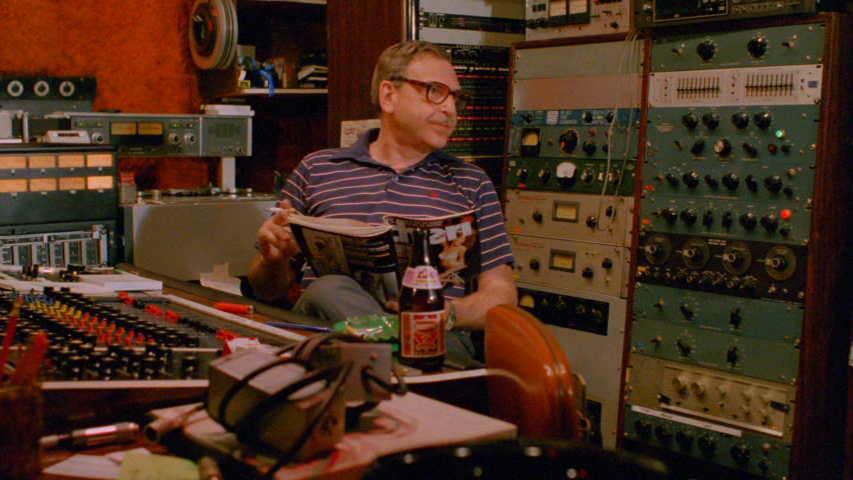
Walter E. Sear in „Lurkers“ (Roberta Findlay, 1988)
To the eternal love of Walter E. Sear and Roberta Findlay
Between the the 27th and 29th of April 2020 the footprint Walter E. Sear left in the world of music, filmmaking but more than that human interaction lingers on especially dominant before gradually retreating again to where all things now unliving and carried on by fond memories alone reside. For today is stuck precisely between what would have been his 90th birthday and what will be the 10th anniversary, the first real milestone, the harshest one for most bereaved, of his passing. Sear, a New Yorker since practically ever, his family moved to Queens when he was only one year old, and forever, was a pioneering recording engineer and tinkerer on all things emitting peculiar sounds, a musician and composer, he produced films, wrote, scored, directed and sold them as successfully as he sold instruments. And that’s only half it, a person like him can only ever be measured in half truths and thinly veiled wonder. He was a true powerhouse of creative thought. Thought that must have connected him easily and even in fleeting everyday passing to another powerhouse of imaginative ventures when they first ran past each other in the decidedly non-romantic offices their different yet closely entwined lines of work made them frequent. Walter E. Sear and Roberta Findlay met in 1976, petty circumstances, while visiting a fellow yet inconsequential for theirs connection and they grew inseparable soon after. Weiterlesen…

„Portraits of Andrea Palmer“, the first feature film for both and directed in conjunction by a certain „C. Huston“ and film preservationist collective Vinegar Syndrome’s Joe Rubin (billed under his film board nom de guerre „J[ohn]. Lyons“), is in many ways an unusual venture – when measured against its date of production, even a deeply anachronistic one. For it is not merely a superficial hommage to the long-gone Golden Age of Porn that raged in American cinemas for some approximately 15 years from the very late 60’s to the mid-80’s, elicits it’s filmic (as in analogue filmmaking, granularity and a color cast unique to employed – 16mm here – stock) as well as organisitional (as in centered around, not working with unsimulated renditions of intercourse) structure, shares it’s curious interest in gloomy subject matter coupled with precise gaugings of female suffering, but actually possesses a profound understanding of it’s highly specific employment of filmed sex like few, if any, modern efforts. Weiterlesen…
April 12, 2020 | Veröffentlicht in
Aktuelles Kino,
Ältere Texte,
André Malberg,
Blog,
Blogautoren,
English,
Essays,
Filmbesprechungen,
Midnight Confessions,
other languages |
Leave a comment
In Schlußakkord erstrahlt beinahe jeder Schauspieler als Star, fast jeder bekommt seinen ‘Auftritt‘, einen Moment, in dem er glänzen darf; und wenn die Kamera auf dem jeweiligen Körper ruht, tritt die Figur aus dem Dunkel der Handlung und ihrer Zweckmäßigkeit heraus – scheint es, als drehe sich in diesem Moment alles nur um sie. Wie müssen diese Gesichter früher von den Kinoleinwänden geleuchtet haben, in silbrigen Nuancen schimmernd, von den Projektoren mit Kohlelampen durchschienen! Weiterlesen…

Gemeinhin sollte man annehmen, dass Filme, die derart huldigend von einem bekannten Schauplatz zum nächsten eilen, wie Cosmotropia de Xams jüngst im Würgegriff der Coronakrise gänzlich digital uraufgeführter „Acid Babylon“ es handhabt, unwillkürlich zur reinen Fanrevue verkommen müssten. „Build on the cosmic spirit of these places“, heißt es im Abspann über ihn selbst sowie seine durch „Lucifer Rising“ (Kenneth Anger, 1980), „Phenomena“ (Dario Argento, 1985) oder „Malpertuis“ (Harry Kümel, 1971) in nicht unbeträchtlichen Teilen des filmkulturellen Gedächtnisses abgelegten Schauplätze. Ein guter Leitfaden für diese strukturell überwältigende, narrativ oder gar didaktisch jedoch schweigsame Versuchsanordnung. Hier werden sie noch einmal ganz neu angelegt, diese Gedächtnisorte des Abseitigen. Weiterlesen…



